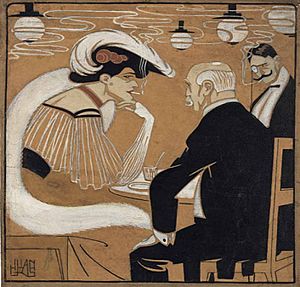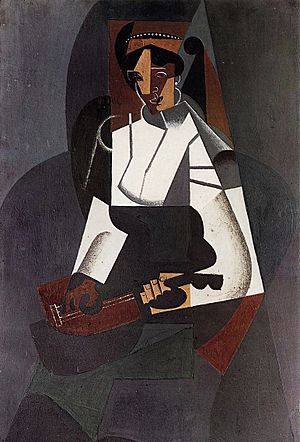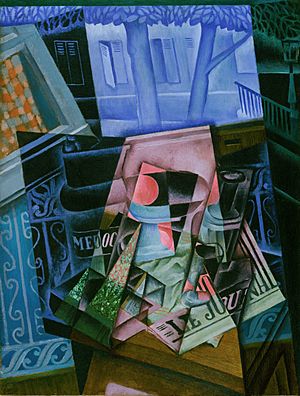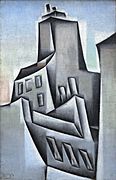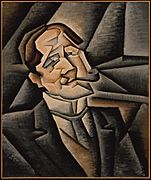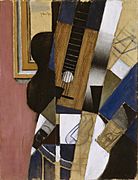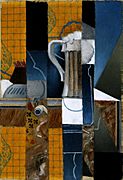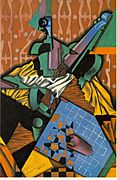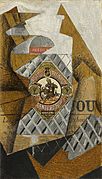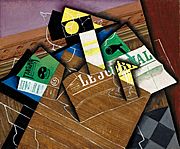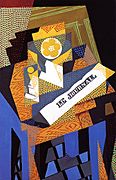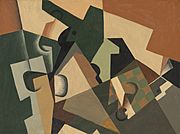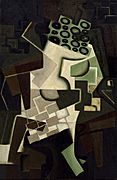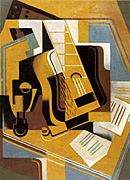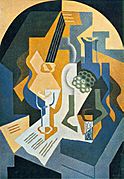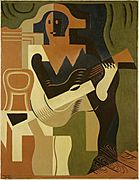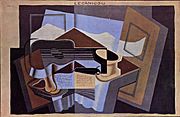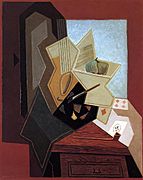Juan Gris facts for kids
Quick facts for kids
Juan Gris
|
|
|---|---|
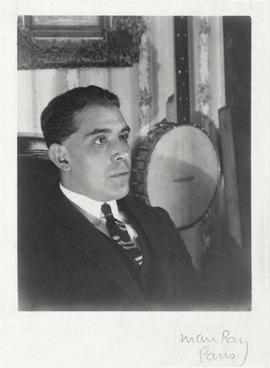
Gris in 1922
(photograph by Man Ray, Paris) |
|
| Born |
José Victoriano González-Pérez
23 March 1887 Madrid, Spain
|
| Died | 11 May 1927 (aged 40) Boulogne-sur-Seine, Paris, France
|
| Nationality | Spanish |
| Known for | Painting, drawing |
| Movement | Cubism |
| Spouse(s) | Lucie Belin |
Juan Gris (born José Victoriano González-Pérez; March 23, 1887 – May 11, 1927) was a Spanish painter. He lived and worked in France for most of his life. His art is a key part of Cubism, a new and exciting art style. His paintings are known for being very unique and important to the movement.
Contents
Life and Early Art Training
Juan Gris was born in Madrid, Spain. He first studied engineering from 1902 to 1904. During this time, he drew pictures for local newspapers. From 1904 to 1905, he learned painting from a traditional artist named José Moreno Carbonero. In 1905, he changed his name from José Victoriano González to Juan Gris. This new name sounded more artistic.
In 1909, Juan Gris and his wife, Lucie Belin, had a son named Georges. The family lived in Paris, France, from 1909 to 1911. Later, Gris met Charlotte Augusta Fernande Herpin, also known as Josette. She became his partner. They lived together in Paris from late 1913 or early 1914 until 1922.
Starting a Painting Career
In 1906, Gris moved to Paris. There, he became friends with many famous artists and writers. These included Henri Matisse, Georges Braque, Fernand Léger, and Pablo Picasso. At first, Gris drew funny pictures for magazines. These magazines included L'Assiette au Beurre and Le Rire.
Gris started painting seriously in 1911. He stopped being a cartoonist to focus on art. He began to create his own special style of Cubism. In 1912, he showed his art for the first time. One of his paintings was called Hommage à Pablo Picasso.
Juan Gris's Cubist paintings were different from Picasso's and Braque's. Gris often used a clear, grid-like structure in his art. This made his paintings feel very organized and planned. He also used bright, lively colors. This was different from the more muted colors used by other Cubist artists.
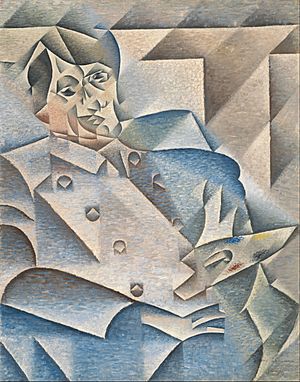
In 1912, Gris showed his art in several important exhibitions. These included the first Cubist group show in Barcelona. He also signed a contract with an art dealer, Daniel-Henry Kahnweiler. This meant Kahnweiler had the only rights to sell Gris's work.
Gris first painted in a style called Analytical Cubism. He even helped name this style. After 1913, he moved to Synthetic Cubism. In this style, he often used collage, where he glued paper onto his paintings. His clear and orderly style influenced other artists.
Crystal Cubism Style
From late 1916 to 1917, Gris's art changed again. This period is called Crystal Cubism. His paintings became even simpler in their geometric shapes. It was harder to tell where objects ended and the background began. Everything seemed to blend into one clear, unified picture.
The geometric shapes in these paintings were very strong. They controlled all the smaller parts of the artwork. Even small details, like faces, became part of the whole design. Gris planned his subjects carefully. But the abstract shapes were the main starting point for his art.
You can see this geometric style in his 1915 painting, Still Life before an Open Window, Place Ravignan. The way the flat shapes overlap creates a strong base for the whole picture. This showed what his future art would look like.
Designer and Art Ideas
In 1924, Juan Gris designed the stage sets and costumes for the famous Ballets Russes. This was a very important ballet company.
Gris also shared his ideas about art. In 1924, he gave a famous lecture at the Sorbonne. It was called Des possibilités de la peinture (The Possibilities of Painting). His art was shown in big exhibitions in Paris and Berlin in 1923, and in Düsseldorf in 1925.
Later Life and Death
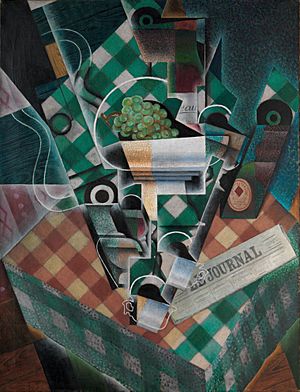
After October 1925, Juan Gris became sick often. He had kidney and heart problems. He died from kidney failure in Paris on May 11, 1927. He was only 40 years old. He left behind his partner, Josette, and his son, Georges.
Famous Artworks
Juan Gris's paintings are very valuable. One of his paintings, Nature morte à la nappe à carreaux (Still Life with Checked Tablecloth) from 1915, sold for $57.1 million. This was a record price for his work.
Here are some of his other well-known paintings:
- Violin Hanging on a Wall (Le violon accroché) (1913)
- Pears and Grapes on a Table (1913)
- Bottle of Rum and Newspaper (Bouteille de rhum et journal) (1914)
- Cherries (Les cerises) (1915)
- Fruit Dish on a Checkered Tablecloth (Compotier et nappe à carreaux) (1917)
Gallery
-
Maisons à Paris (Houses in Paris), 1911, Solomon R. Guggenheim Museum, New York
-
Juan Legua, 1911, Metropolitan Museum of Art, New York
-
Glass of Beer and Playing Cards, 1913, Columbus Museum of Art, Ohio
-
Fantômas, 1915, National Gallery of Art, Washington, D.C.
-
Glass and Checkerboard, c. 1917, National Gallery of Art
-
Compotier et nappe à carreaux, 1917, Solomon R. Guggenheim Museum, New York
-
The Guitar (La Guitarra), 1918, Fundación Telefónica at Queen Sofia Museum, Madrid
-
Le Canigou, 1921, Albright–Knox Art Gallery, Buffalo, New York
-
The Painter's Window, 1925, Baltimore Museum of Art, Maryland
See also
 In Spanish: Juan Gris para niños
In Spanish: Juan Gris para niños


